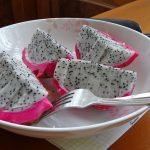While most fruits are relatively acidic, dragon fruit (also known as pitaya) leans more on the alkaline side. While the tropical fruit does contain a limited amount of acid, the pH level of the tropical fruit is surprisingly mild.
On average, dragon fruit has an acidic pH ranging from 6.0 to 7.0. Dragon fruit (or pitaya) is only mildly acidic to neutral, mainly because of the large number of alkalizing minerals and high water content contained within the fruit. The acidity of dragon fruit is comparable to that of a honey dew or cantaloupe melon.
This means that the pitaya is an outlier compared to many of the common fruits you’ll find in the supermarket. Citrus fruits are obvious candidates, but even berries like strawberries are much more acidic in nature. People suffering from acid reflux problems should definitely consider a healthy dragon fruit juice every once in a while!
Dragon Fruit Is Barely Acidic
People suffering from acid reflux problems might be delighted to learn about the mildness of dragon fruit. It means there’s virtually no risk related to heartburn. But that’s not the only benefit that should be celebrated.
Pitayas are also very light on the teeth, since the neutral pH of the fruit will barely cause tooth enamel to be damaged during consumption. More importantly, the surprisingly low sugar content of the fruit reduces the risk of cavities and is great for any diet.
This doesn’t mean that regular daily dental care isn’t important. You should definitely keep brushing those pearly whites twice a day. However, it’s not necessary to wait at least 30 minutes after consuming this tropical fruit. That’s something you would need to do for highly acidic fruits like blueberries. And yet, there’s still a little bit of acid left in your average pitaya.
How Much Acid Is In Dragon Fruit?
Considering the mild to neutral pH value of dragon fruit, the acid content of dragon fruit is low. The most important acidic substance in dragon fruit is citramalic acid, accounting for 7.56-71.42% of total acid. The maximum concentration in dragon fruit pulp was 12.9 mg/g.
Apart from trace amounts of citramalic acid, other types of acid in dragon fruit exist in the form of vitamins and minerals. They are harmless for practically all people, including those that might be considered a risk group. There are no poisonous substances in dragon fruit.
This puts the pitaya in a unique position, where it is both a very nutritious and healthy fruit that’s low in sugar, but also a fruit that’s practically non-acidic. In a way, it might just be the ultimate healthy tropical fruit with the best of both worlds. Only the coconut might be a fruit that’s similar in this regard.
Dragon Fruits Are Safe For Acid Reflux
If you’re suffering from acid reflux, having fruits can be akin to walking in a minefield. You really need to know which fruits are safe for you. Luckily, the dragon fruit is one of the safest options for people that suffer from heartburn-related symptoms.
Especially because these tropical delicacies are so mild in terms of pH level and high in nutritional value, they are one of the best alternatives to more acidic fruits.
There are no restrictions on consuming pitayas for Gastroesophageal reflux disease (GERD) patients either. However, it must be noted that daily consumption can have some negative side effects. Dragon fruit can have a mild laxative effect, and it might cause some bloating and gas (especially on an empty stomach).
No Acidity Danger For Risk Groups
Other risk groups should also not be afraid to eat some dragon fruit. The pulp is completely safe for babies and adults alike. If you’re able to digest solid foods you can absolutely have yourself a delicious pitaya every once in a while.
The mild nature of the fruit makes it a perfect ingredient in any type of fruit mix, and will provide you with a range of important vitamins and minerals. These range from fiber to magnesium, and from iron to vitamin C.
It’s safe to say that there’s no particular risk group that should avoid this fruit for any reason. They’re even a great addition to people on a diet, as they are relatively low in sugar and calories.
Dragon Fruits Are Mild And Nutritious
Sometimes you come across a fruit that’s nothing short of a ‘superfood’. The pitaya can absolutely be considered a fruit in the elite status, at least when it comes to nutrition and acidity mildness.
Some people feel like the common white-pink variety lacks flavor, but there are also red and yellow options which are much more flavorful! Do keep in mind that these colorful alternatives to the common pitaya do contain slightly more sugar. Here’s a comparison for the red pitaya, and this article describes how the yellow variety of the dragon fruit is different.
Be comfortable in the knowledge that dragon fruits are mild, neutral fruits with very low acidity levels. Enjoy the tropical delicacy and feel free to add it to your rotation of healthy snacks. Bon appetit!



